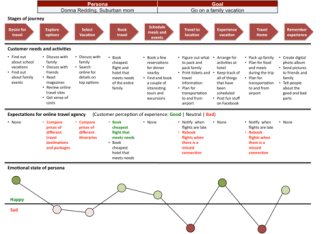Understanding your customer journey is key in providing a frictionless customer experience— and reaping the finacial benefits that come with it. That is why customer journey mapping carries so much weight. With no serious drawing skills necessary, a customer journey or customer experience map is simply a visual way to:
- List each touchpoint with customers, from first to final
- Rate each touchpoint for customer satisfaction.
Journey mapping will provide a better understanding of how to best structure your touchpoints to create an effective and efficient process for your customers. View our example customer journey map and then try creating your own. Here’s what you’ll need to get started:

Free Guide: The Modern Small Business Playbook
DownloadCustomer Journey Map Example
Here’s an example of a customer journey map for small businesses.

Notice how this map is broken up like a timeline. There are notes at each step that explain what the customer is doing at this point in their experience and how your business can meet their needs.
How to Create a Customer Journey Map
Here’s how you can create a simple customer journey map for your small business.
1. Define personas.
Create profiles, or personas, of key customer types. List their hopes, wants, expectations and fears. This will require some research. Interviewing employees, working a shift in a customer-facing role, listening to recordings of customer service calls, and mining any data you’ve collected in a customer relationship management (CRM) system are great ways to gather information.
Consider snagging some valuable customer feedback through a questionnaire. Whether they’ve purchased a product or service from you in the past or plan to in the future, you’ll want their comments.
Questions to ask
- How did you hear about us?
- How easy is our website to navigate?
- Have you ever purchased with us?
- Did you ever require customer support? Rank it on a scale of 1 – 10.
- What problems do you need to solve?
If this is your first map, feel free to select the most common customer personas and reflect on their typical route. Try not to make them too broad. Grouping too many personas won’t accurately reflect your customers’ journey.
Lengths can vary when creating the timelines for your customer journey based on the persona. It could be as short as scheduling an appointment or so long it covers from first hearing about your business to making a purchase.
2. Cover all touchpoints.
If your customer can interact with it on your business site, it’s a touchpoint. Listing out each touchpoint that customers and prospects are performing provides extensive insight. Are customers not using many touchpoints while on the page? There may be a big reason they’re leaving the page so soon. Looking like there are too many touchpoints used? Your website or processes might be more complicated than you thought. Recognize when you’re expecting customers to take too many steps. Whittling the step down may see risky, but it’ll pay off in conversions.
The overall goal is to understand and simplify the total customer journey. This doesn’t stop at your website though. Note every way that your customers come across your site online— social platforms, ads, email marketing, third-party sites, reviews. Not sure where you’re popping up? Run a Google search of your brand to see what pages mention your business.
3. Tap into emotions.
Marketing is a result of cause and effect. It’s time you think about your customers in the same way. Their actions are emotionally driven. Emotions can swing from positive to negative depending on where they are in the journey. Take note of this range of possible mood changes for each phase of the timeline.
Be honest about the frustrations your processes create for your clients. Those emotions are usually caused by a pain point. Highlight and correct these issues. Being able to note these moods will help your business learn what content or service to provide to soothe the customer. This can determine the reputation of a business with that customer. Certain policy getting under the skin of one too many customers? Try something like, “Yes, we have a 30-day return policy, but we’d be happy to make an exception for you.”
4. Map the customer’s journey.
Your “map” could be sticky notes stuck on a whiteboard, written-out lists or a digital document. Personally, we suggest the latter for the ease of distribution around the company. There are multiple types of customer journey maps and each serves its own purpose. Determining which map best suits your needs, is the first step to mapping out your customer journey.
4 Types of Maps
- Current State maps are most commonly used for those continuously looking to improve the customer journey. It visualizes the actions, thoughts and emotions customers currently experience while they interact with your company.
- Day in the Life maps visualize actions, thoughts and emotions your customers experience on a daily basis whether it includes your company or not. This mapping type focuses on customers’ real-life pain points to address unmet needs they don’t even know exist.
- Future State maps visualize what you believe will be the actions, thoughts and emotions that customers will experience in their future interactions with your company. Think of this map type as where you want to be. It’s a great way to communicate your vision and set clear objectives.
- Service Blueprint maps begin with one of the above maps but then layers in every area responsible for delivering on experience. This includes people, policies, technologies used and processes in place. If you’re looking to highlight root issues to correct, this is ideal.
Remember nothing is one-size-fits-all. You’ll want a map for each persona and guidelines in place for one-off customers who have no plans of being pacified.
5. Test and analyze your map.
Once you complete your customer journey map, you’re welcome to wipe the sweat off your brow. We’re proud but you’re not done yet. It’s time to gather and analyze data. How many people left your website before a purchase was made? How can you improve customer service? With your journey map in hand, these are examples of questions you should be able to answer. Test out your map for yourself.
Go through each persona. By following the journey yourself, you’ll notice the necessary changes to make to reach your goals and increase conversion rates. That change may be a more specific call-to-action or better detailing in the product description. Changes big and small are all effective when you’re working off data. Blind changes rarely result in improved experiences.
Remember to review your map regularly, especially if new products change the customers’ journey. Decide whether that review is monthly or quarterly for your business. Think of this as an ongoing project to streamline your processes and you’ll continue to see the benefit of customer journey and experience maps.

Modern Small
Business Playbook
Find expert tips and tools to help you streamline communications, automate your marketing efforts, improve your business operations, and more in this free guide.


